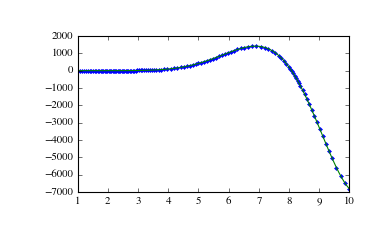Examples¶
This module contains example(s) of solving boundary value problems using the bvp package.
- scikits.bvp1lg.examples.bessel_colnew()¶
Examples
Let’s use colnew to solve a multi-point boundary value problem for the Bessel differential equation and another coupled differential equation:
u''(x) = -u'(x) / x + (nu**2/x**2 - 1) * u(x) for 1 <= x <= 10 u(1) = J_{nu}(1) u(10) = J_{nu}(10) v'(x) = x**(nu+1) * u(x) for 1 <= x <= 10 v(5) = 5**(nu+1) * J_{nu+1}(5)First import numpy and bvp
>>> import numpy as np >>> import scipy.special as special
>>> import scikits.bvp1lg.colnew as colnew
Then specify the equation system
>>> nu = 3.4123
>>> degrees = [2, 1] >>> def fsub(x, z): ... u, du, v = z # it's neat to name the variables ... return np.array([-du/x + (nu**2/x**2 - 1)*u, x**(nu+1) * u])
Here, fsub is vectorized over x: x has shape (nx,) and z shape (mstar, nx), where mstar = 3 is the number of free variables: u, du and v. fsub should return a vector of shape (ncomp, nx) where ncomp is the number of equations.
The partial derivatives wrt. variables can be provided, to gain speed
>>> def dfsub(x, z): ... u, du, v = z ... zero = np.zeros(x.shape) ... return np.array([[(nu**2/x**2 - 1), -1/x, zero], ... [ x**(nu+1), zero, zero]])
zero is needed due to vectorizing.
The boundary points must be sorted:
>>> boundary_points = [1, 5, 10]
and the boundary conditions given in form
>>> def gsub(z): ... u, du, v = z ... return np.array([u[0] - special.jv(nu, 1), ... v[1] - 5**(nu+1) * special.jv(nu+1, 5), ... u[2] - special.jv(nu, 10)])
Here, z[i,j] is the value of variable i at boundary point j. Note that only separated boundary conditions are supported: condition at point j may only refer to z[:,j].
Again, the partial derivatives can be provided
>>> def dgsub(z): ... return np.array([[1, 0, 0], ... [0, 0, 1], ... [1, 0, 0]])
dgsub(z)[i,:] contains the partial derivative of the boundary condition at boundary point i versus the three variables.
Then solve the problem (it is linear)
>>> tol = [1e-5, 0, 1e-5] >>> solution = colnew.solve( ... boundary_points, degrees, fsub, gsub, ... dfsub=dfsub, dgsub=dgsub, ... is_linear=True, tolerances=tol, ... vectorized=True, maximum_mesh_size=300)
To satisfy the tolerances, we needed to increase the maximum mesh size from the default 100 to 300. The actual final mesh has 117 points:
>>> solution.nmesh 117
Finally, check that the u variable indeed is J_nu(x)
>>> x = np.linspace(1, 10, 101) >>> np.allclose(solution(x)[:,0], special.jv(nu, x), ... rtol=1e-4, atol=1e-8) True
Due to a property of the Bessel functions, v(x) = x**(nu+1) J_{nu+1}(x)
>>> np.allclose(solution(x)[:,2], x**(nu+1)*special.jv(nu+1, x), ... rtol=1e-4, atol=1e-8) True
Note that in this case the algorithm slightly underestimated the errors: the solutions do not satisfy the specified tolerance 1e-5, although they satisfy the tolerance 1e-4.
Finally, we can plot the result:
>>> import matplotlib.pyplot as plt >>> plt.plot(solution.mesh, solution(solution.mesh)[:,2], '.', ... x, x**(nu+1)*special.jv(nu+1, x), '-') [...] >>> plt.show()
